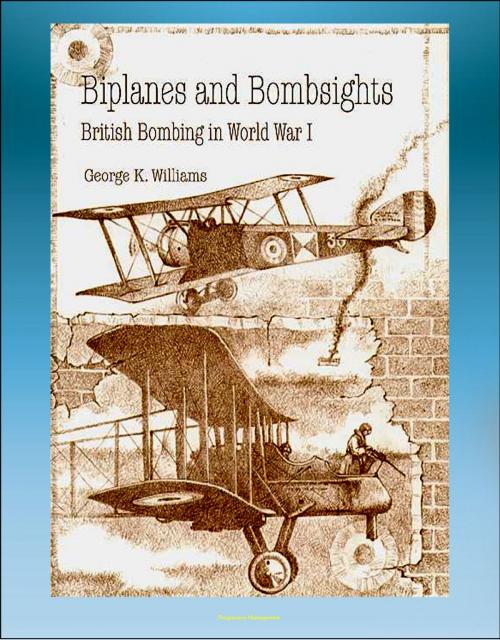Biplanes and Bombsights: British Bombing in World War I - Sopwith Strutter, Zeppelin, Dehavilland, Handley Page, General Hugh Trenchard, Lord Rothermere
Nonfiction, History, Military, Aviation, World War I| Author: | Progressive Management | ISBN: | 9781476306445 |
| Publisher: | Progressive Management | Publication: | June 22, 2012 |
| Imprint: | Smashwords Edition | Language: | English |
| Author: | Progressive Management |
| ISBN: | 9781476306445 |
| Publisher: | Progressive Management |
| Publication: | June 22, 2012 |
| Imprint: | Smashwords Edition |
| Language: | English |
This study develops and substantiates a comprehensive evaluation of British long-range bombing in the First World War. Its findings run directly counter to the generally held opinion. Natural limitations, technical shortfalls, and aircrews lacking proficiency acted in concert with German defenses to produce far less results than those claimed.
In broad brush, this study balances wartime claims against actual results as determined after hostilities. It also documents the cost, in men and equipment, of the bombing offensive waged by 3 Wing, Royal Naval Air Service, and components of the Royal Flying Corps and the Royal Air Force—specifically 41 Wing, Eighth Brigade, and Independent Force, between July 1916 and the Armistice. The study's organization was based on the organizational scheme of Sir Charles Webster and Noble Frankland in their four-volume history of Bomber Command in World War II, The Strategic Air Offensive Against Germany. Maj Gen Hugh M. Trenchard's Independent Force, the major strategic force to undertake significant and protracted bombing operations in the Great War, levered into place the cornerstone of the postwar Royal Air Force and shaped its doctrine during the interwar years. It also conditioned domestic expectations concerning the offensive potential of aerial campaigns in any future conflict. The lessons supposedly gleaned from the Great War heavily influenced the progress of British military aviation during the 1920s and 1930s, underpinning RAF doctrines, expectations, and policies up to the initial phases of the Second World War. The subject thus deserves careful study in its own right. Fundamental discrepancies between the materials and conclusions reported in the January 1920 Air Ministry's classified evaluation of the Great War's long-range bombing offensive on the one hand, and those contained in seven volumes of evidence gathered firsthand by RAF intelligence officers who surveyed German-occupied territory immediately after the Armistice on the other, prompted an initial interest in this aspect of military history. Data from seldom-consulted records of the bombing study conducted independently by the United States Air Service complicated these differences. Subsequent examinations of RAF, Air Ministry, and other official archives brought even more contradictions to light.
Contents * FOREWORD * INTRODUCTION * Chapter 1 * NO. 3 WING ROYAL NAVAL AIR SERVICE (JULY 1916-MAY 1917) * Notes * Chapter 2 * BRITISH BOMBING BEGINS * Notes * Chapter 3 * 41ST WING ROYAL FLYING CORPS (JUNE 1917-JANUARY 1918) * Notes * Chapter 4 * EIGHTH BRIGADE AND INDEPENDENT FORCE (FEBRUARY-NOVEMBER 1918) * Notes * Chapter 5 * EIGHTH BRIGADE AND INDEPENDENT FORCE OPERATIONS * Notes * Chapter 6 * POSTWAR ASSESSMENTS
This study develops and substantiates a comprehensive evaluation of British long-range bombing in the First World War. Its findings run directly counter to the generally held opinion. Natural limitations, technical shortfalls, and aircrews lacking proficiency acted in concert with German defenses to produce far less results than those claimed.
In broad brush, this study balances wartime claims against actual results as determined after hostilities. It also documents the cost, in men and equipment, of the bombing offensive waged by 3 Wing, Royal Naval Air Service, and components of the Royal Flying Corps and the Royal Air Force—specifically 41 Wing, Eighth Brigade, and Independent Force, between July 1916 and the Armistice. The study's organization was based on the organizational scheme of Sir Charles Webster and Noble Frankland in their four-volume history of Bomber Command in World War II, The Strategic Air Offensive Against Germany. Maj Gen Hugh M. Trenchard's Independent Force, the major strategic force to undertake significant and protracted bombing operations in the Great War, levered into place the cornerstone of the postwar Royal Air Force and shaped its doctrine during the interwar years. It also conditioned domestic expectations concerning the offensive potential of aerial campaigns in any future conflict. The lessons supposedly gleaned from the Great War heavily influenced the progress of British military aviation during the 1920s and 1930s, underpinning RAF doctrines, expectations, and policies up to the initial phases of the Second World War. The subject thus deserves careful study in its own right. Fundamental discrepancies between the materials and conclusions reported in the January 1920 Air Ministry's classified evaluation of the Great War's long-range bombing offensive on the one hand, and those contained in seven volumes of evidence gathered firsthand by RAF intelligence officers who surveyed German-occupied territory immediately after the Armistice on the other, prompted an initial interest in this aspect of military history. Data from seldom-consulted records of the bombing study conducted independently by the United States Air Service complicated these differences. Subsequent examinations of RAF, Air Ministry, and other official archives brought even more contradictions to light.
Contents * FOREWORD * INTRODUCTION * Chapter 1 * NO. 3 WING ROYAL NAVAL AIR SERVICE (JULY 1916-MAY 1917) * Notes * Chapter 2 * BRITISH BOMBING BEGINS * Notes * Chapter 3 * 41ST WING ROYAL FLYING CORPS (JUNE 1917-JANUARY 1918) * Notes * Chapter 4 * EIGHTH BRIGADE AND INDEPENDENT FORCE (FEBRUARY-NOVEMBER 1918) * Notes * Chapter 5 * EIGHTH BRIGADE AND INDEPENDENT FORCE OPERATIONS * Notes * Chapter 6 * POSTWAR ASSESSMENTS















